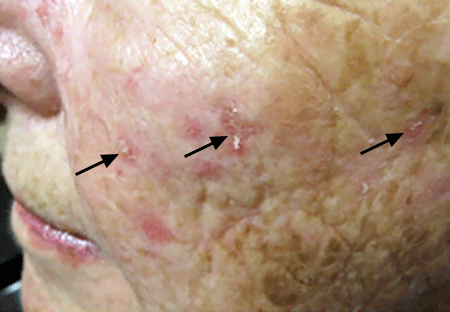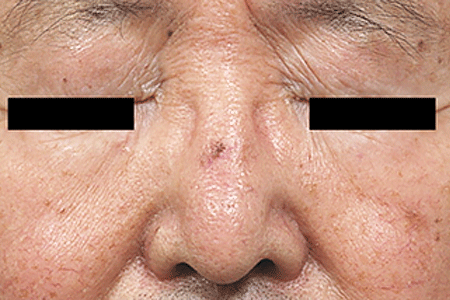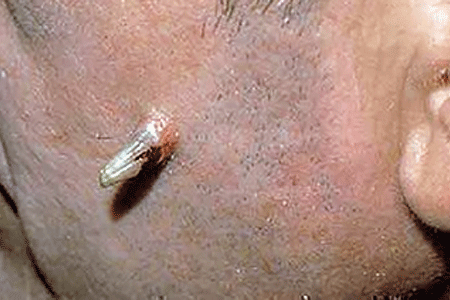How to spot a precancerous growth on your skin
If you have any growths on your skin that look like these, you may have a precancerous growth called actinic keratosis (AK).
Where we get precanceorus skin growths
Precancerous skin growths develop on skin that’s gotten lots of sun over the years. If you haven’t protected your skin from the sun, you may have precancerous skin growths. Called AKs, these growths usually appear after 40 years of age.

Actinic keratosis can appear before 40 years of age
If you live in an area that gets intense sunlight all year, such as Florida or Arizona, and haven’t protected your skin from the sun, you may get AKs earlier. AKs also often appear earlier in people who use tanning beds and sun lamps.

What to look for
Signs that you have AKs are often subtle. AKs usually begin as a patch of rough-feeling skin. When rubbed, the rough patch may feel painful. The following images show you what AKs typically look like.
Actinic keratosis often form on the face
AKs tend to be dry, scaly, and pink or red patches on the skin.

Actinic keratosis are common on the backs of the hands
AKs form on skin that’s received lots of sun over the years. This patient’s many age spots and AKs indicate lots of sun exposure. Arrows point to the AKs, which are the reddish pink spots.

Actinic keratosis may be covered with scale
AKs can appear as white, scaly, wart-like growths on the skin, as seen here on this patient’s hand.

Actinic keratosis usually develop on the face, hands, or bald scalp
While many AKs are red or pink, some appear as brown spots. This man has a brownish AK. It’s the spot you see on his nose.

Some actinic keratosis look like age spots
These brown patches, which could be mistaken for age spots, are AKs. Unlike age spots, AKs tend to feel rough.

Actinic keratosis can form on the lip
A white, rough-feeling patch on your lip could be an AK. When an AK forms on the lip, the lips often feel extremely dry and may crack easily. It’s especially important to see a dermatologist if you notice any of these changes to your lip.

An actinic keratosis can look like a horn
While any AK can turn into a skin cancer, horns are more likely to do so. If you have a horn-like growth on your skin, it’s definitely time to see a dermatologist.

A dermatologist should examine all actinic keratosis
If you find anything on your skin that looks (or feels) like an AK, you should see a dermatologist. AKs are precancerous growths, and some turn into a type of skin cancer called squamous cell carcinoma. Being under a dermatologist’s care can help you get the treatment you need.
Related AAD resources
Actinic keratosis (AKs): Overview, symptoms, causes, and treatment
Squamous cell carcinoma: Overview, symptoms, causes, and treatment
Images
Image 3: Journal of the American Academy of Dermatology. J Am Acad Dermatol. 2017;76(2):349-50.
Image 4: Journal of the American Academy of Dermatology. J Am Acad Dermatol. 2016;74(5):981-1004.
Images 5 and 9: Journal of the American Academy of Dermatology. J Am Acad Dermatol. 2000;42:S8-10.
Image 6: Journal of the American Academy of Dermatology. J Am Acad Dermatol. 2010;62(1):85-95.
Images 7 and 8: Images used with permission of the American Academy of Dermatology National Library of Dermatologic Teaching Slides.
References
Moy RL, “Clinical presentation of actinic keratoses and squamous cell carcinoma.” J Am Acad Dermatol 2000;42:S8-10.
 Atopic dermatitis: More FDA-approved treatments
Atopic dermatitis: More FDA-approved treatments
 Biosimilars: 14 FAQs
Biosimilars: 14 FAQs
 How to trim your nails
How to trim your nails
 Relieve uncontrollably itchy skin
Relieve uncontrollably itchy skin
 Fade dark spots
Fade dark spots
 Untreatable razor bumps or acne?
Untreatable razor bumps or acne?
 Tattoo removal
Tattoo removal
 Scar treatment
Scar treatment
 Free materials to help raise skin cancer awareness
Free materials to help raise skin cancer awareness
 Dermatologist-approved lesson plans, activities you can use
Dermatologist-approved lesson plans, activities you can use
 Find a Dermatologist
Find a Dermatologist
 What is a dermatologist?
What is a dermatologist?